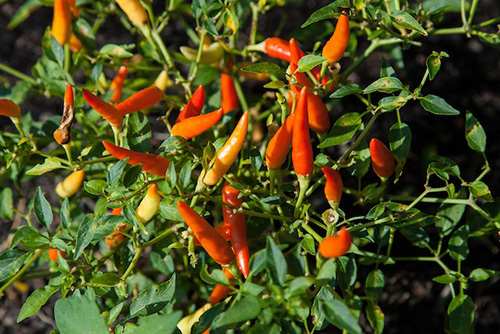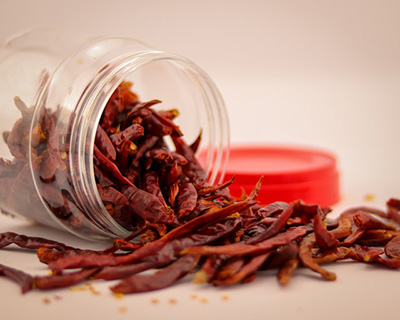The cayenne pepper plant (Capsicum annuum) is a revered member of the chili family that has played an essential role in culinary, medicinal, and cultural landscapes for centuries. Its fiery flavor makes it stand out from other plants, while its remarkable health benefits make it even more special.
The cayenne pepper plant has been cultivated for over 7,000 years in South and Central America. Called after the city of Cayenne in French Guiana, this chili species eventually spread across various regions through trade and exploration efforts. Today it remains a popular ingredient used worldwide due to its unique flavor profile. With such a rich history behind it, one can only imagine what other culinary delights await us as we travel into uncharted territories!
Cayenne pepper plants thrive in warm and sunny climates, ideal for tropical or subtropical regions. They require well-drained, moist soil but can tolerate some drought conditions as needed. The plant routinely grows to a height of two to four feet with long slender green leaves adorning it until maturity, when they transform from green into bright red, signaling readiness for harvest.
Cayenne peppers are a chief ingredient in many cuisines worldwide, adding an unmistakable kick to various dishes. The compound responsible for this spiciness is capsaicin which triggers the release of endorphins resulting in both pleasure and mild euphoria upon consumption. This unique combination makes cayenne pepper one of nature’s most exciting flavors that people love incorporating into their meals!
Cayenne pepper is a versatile spice used in various forms – fresh, dried, or ground into powder. When added judiciously, its distinctive flavor profile adds depth and complexity to any meal. This ingredient is an absolute must-have for those who enjoy bold tastes! Try incorporating it into your following recipe for a unique twist on traditional cuisine.

The Health Benefits of Cayenne Pepper
- Parts Used: Fruit
- Properties: Astringent, antispasmodic, stimulant, carminative
- What it Affects: Heart, circulation, kidneys, stomach
Cayenne pepper has been used for centuries in traditional medicine systems across various cultures due to its powerhouse of health benefits. Its active compound capsaicin is one reason this spice offers so much value when promoting overall wellness. To explore further the many advantages provided by cayenne peppers, let’s take an extensive look at their potential impact on our bodies:
Pain Relief and Anti-Inflammatory Benefits
Cayenne pepper has long been revered for its ability to provide pain relief. This is due in large part to the presence of capsaicin. This active compound works as a natural analgesic when applied topically. By desensitizing nerve receptors, it reduces sensations of discomfort associated with conditions such as arthritis, muscle strains, or backaches, among others. Moreover, anti-inflammatory properties further aid in reducing swelling and inflammation in affected areas. Therefore cayenne pepper’s benefits make it an excellent choice for anyone seeking an effective yet safe remedy against chronic pains without resorting to medicines with potential side effects.
Digestive Health
Its ability to stimulate gastric juice production can help alleviate symptoms associated with indigestion, bloating, and flatulence. Additionally, it may promote gut health by eliminating harmful bacteria while supporting the growth of beneficial flora in our intestines. This makes Cayenne pepper an excellent choice when looking for ways to improve overall well-being through better nutrition.
Heart Health
This plant has been found to have potential benefits for cardiovascular health. The compound capsaicin is believed to reduce cholesterol levels by promoting LDL (bad) cholesterol breakdown within liver cells. This reduction contributes positively towards better heart function and decreased risk of developing heart disease. Additionally, cayenne peppers support circulation by relaxing blood vessels, improving blood flow, and lowering hypertension. These findings suggest that incorporating this spice into one’s diet could be beneficial for maintaining optimal overall well-being.
Weight Management
Research suggests that it may increase metabolism rates leading to higher calorie burns when combined with healthy eating habits and regular exercise routines. Moreover, this active ingredient also acts as an appetite suppressant which can help reduce overall calorific intake. So if you’re looking for ways to manage your weight, consider incorporating cayenne peppers into your diet!
Loaded with Vitamins
The plant contains significant amounts of vitamins A and C, essential for maintaining a healthy immune system. Vitamin C helps protect against harmful free radicals while boosting the body’s natural defenses against infection or illnesses. Meanwhile, vitamin A preserves skin integrity by creating barriers against pathogens entering through mucous membranes.
Migraine Pain Management
Research suggests that capsaicin may hold promise in alleviating migraine symptoms. Applying a topical cream containing this compound to the forehead or temples can reduce their frequency and severity by blocking the neuropeptides that trigger these headaches. This approach is worth considering for those struggling with chronic pain from frequent attacks.
Respiratory Health
Cayenne pepper is known for its warming and stimulating properties, which can benefit the respiratory system. It helps break up mucus, making it easier to expel while relieving symptoms like sinusitis or bronchitis.
Anti-Cancer Potential
Studies suggest that it can induce apoptosis (cell death) in cancer cells and suppress tumor growth while limiting the spread of certain types of cancers, such as prostate or pancreatic cancer. As more research is conducted on this topic, we may discover even more significant potential for using cayenne peppers therapeutically against these deadly diseases.
The Side Effects of Cayenne Pepper Plant

While cayenne pepper has numerous health benefits when used medicinally, it is crucial to recognize potential side effects, notably if consumed in large quantities or applied topically using concentrated forms. The compound responsible for its spiciness and therapeutic properties may cause the following adverse reactions:
Consuming large amounts of cayenne pepper can cause pain in the lining of your gastrointestinal tract leading to uncomfortable symptoms such as stomach pain, cramping, and diarrhea. Those with sensitive stomachs or pre-existing conditions like IBS or gastritis are more susceptible to these effects from consuming excessive amounts of this spice. It is advisable for individuals who fall into either category to exercise caution when using it.
When applied topically, capsaicin can cause skin irritation and burning sensations. It is essential not to use these cayenne products on broken or sensitive areas, as they may worsen existing conditions. If you experience discomfort after using capsaicin creams/ointments, consult your doctor immediately for further guidance.
Cayenne pepper may have unintended consequences when used alongside medications such as blood thinners or anticoagulants. The capsaicin in cayenne could potentially increase the risk of bleeding if taken with these drugs. If you are taking any prescription medication, consult your healthcare provider before using Cayenne for medical purposes to avoid negative interactions between them. Safety is paramount!

Cayenne pepper’s spicy nature can trigger or exacerbate heartburn and acid reflux in specific individuals. Capsaicin may loosen the lower esophageal sphincter allowing stomach acids to pour back into the esophagus, causing discomfort. If you experience these symptoms after consuming cayenne pepper, it is best avoided until your condition improves.
Topical application of cayenne pepper products over an extended period can cause skin sensitivity to increase. This may result in a heightened reaction towards even mild irritants or exposure to sunlight. Prolonged use could lead to long-term effects on the skin’s ability to tolerate these stimuli. Therefore caution should be exercised when using such products for lengthy periods.
Accidental contact with cayenne pepper or its products can result in severe eye irritation. To avoid this unpleasant experience, you must avoid touching your eyes after handling these substances and ensure you wash your hands thoroughly afterward.
Pregnant and breastfeeding women should exercise caution when consuming cayenne pepper medicinally. While small amounts used in cooking are generally considered safe, pregnant or lactating individuals should consult with a healthcare professional before taking any supplements containing this spice, as they may pose risks during these stages of life.
Preparation and Dosage
- Infusion: One teaspoon to one cup boiling water, taken in ½ fluid ounce doses. Pour the water over the cayenne.
- Tincture: Take 5 to 15 drops three times daily.
- Fluid Extract: Take ten to 15 drops three times daily.
- Oil: For toothaches, clean the cavity and soak cotton in the oil; use sparingly, as it is very potent.
- Powder (internal): Take one to two #0 capsules (1 to 10 grains) thrice daily.
- Powder (external): For external bleeding, powder may be placed directly on the wound.
The cayenne pepper plant is not just another ingredient in the culinary world; it represents a treasure trove of flavor, history, and health benefits. From its origins in the New World to its widespread use across global cuisines and traditional medicine, this fiery chili pepper has left an indelible mark on human culture. Whether you’re a food enthusiast or someone who values their well-being highly, the cayenne pepper plant invites you to experience its spicy charm while reaping the benefits that come with it. So when savoring dishes infused with cayenne peppers, take some time to appreciate how richly steeped in heritage and remarkable stories these small but mighty spices are!
WARNING: Very excessive use can damage the kidneys and lead to pleurisy or gastroenteritis. Prolonged contact with the skin can cause dermatitis and raise blisters. When cooked, it becomes an irritant. It is best to use cayenne primarily as a medicine and only minimal amounts as a food additive. Apply it with a glove.
Health Disclaimer: The information on this website is for educational uses only and is not a substitute for professional medical advice. Always consult an authorized healthcare provider for any health concerns before using any herbal or natural remedy. We do not establish, treat, cure, or prevent any disease. Reliance on any material from this website is solely at your own risk. We are not responsible for any adverse effects resulting from the use of information or products mentioned on this website.
REFERENCES
- Vance Ferrell Harold M. Cherne, M.D. The Natural Remedies Encyclopedia [Book]. – Altamont, TN: Harvestime Books, 2010. – Vol. Seventh Edition: 7: pp. 150.
- Pain Relief: https://www.ncbi.nlm.nih.gov/pmc/articles/PMC4043944
- Metabolism Boost: https://pubmed.ncbi.nlm.nih.gov/19890029
- Anti-Inflammatory: https://pubmed.ncbi.nlm.nih.gov/22445013
- https://pubmed.ncbi.nlm.nih.gov/26590112
- https://pubmed.ncbi.nlm.nih.gov/19407068
- https://www.ncbi.nlm.nih.gov/pmc/articles/PMC4043944
- https://pubmed.ncbi.nlm.nih.gov/27103588
- https://fdc.nal.usda.gov/fdc-app.html#/food-details/170601/nutrients
- https://pubmed.ncbi.nlm.nih.gov/24681639
